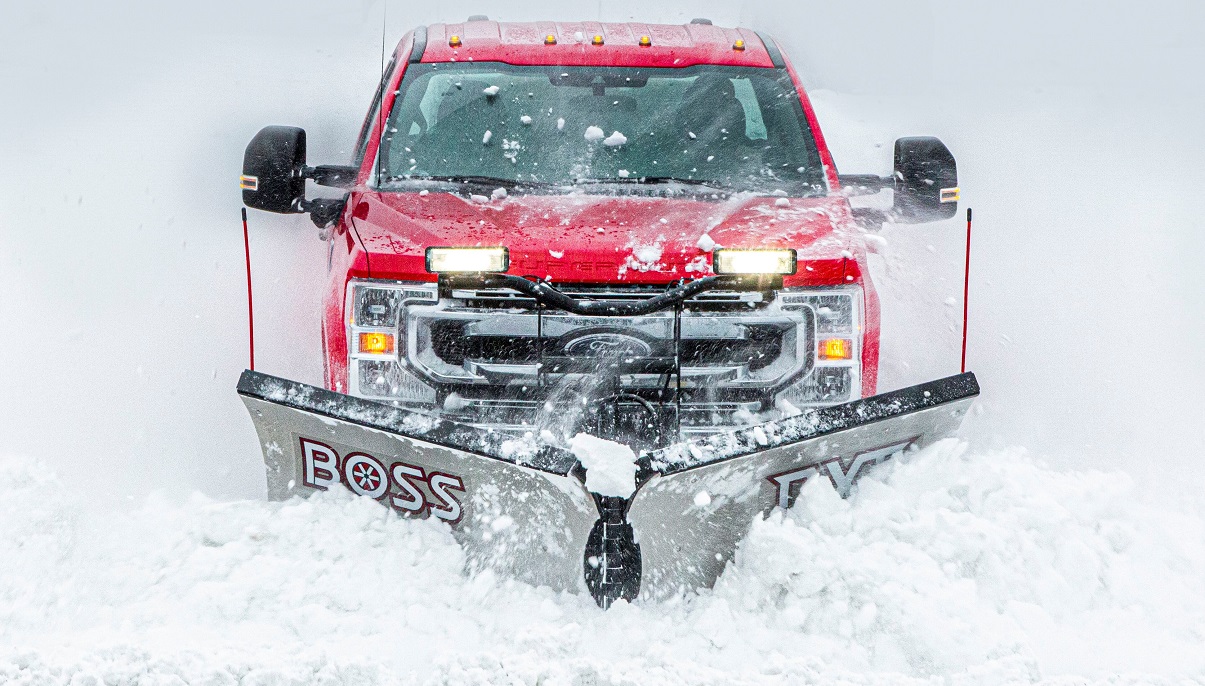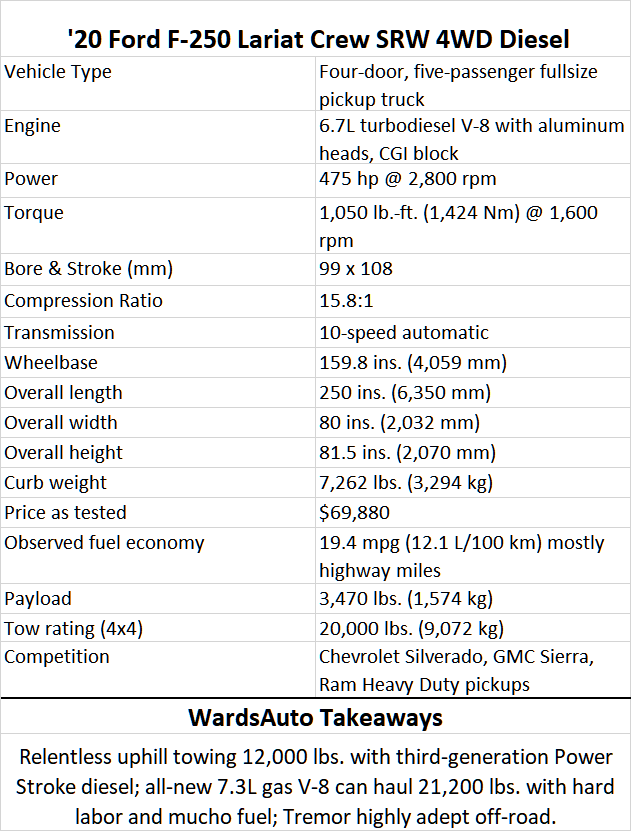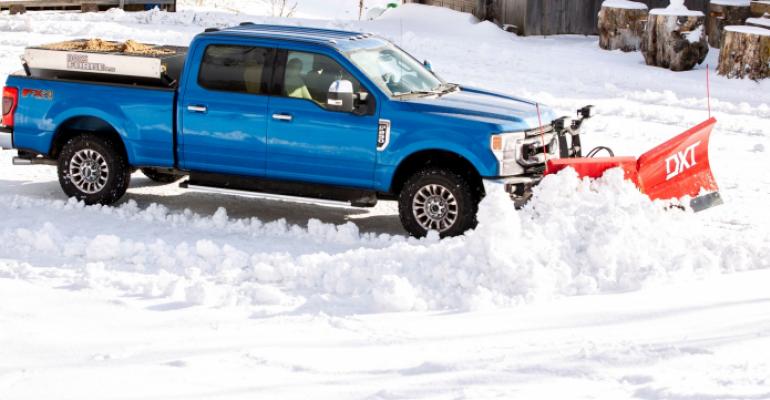PHOENIX – Chugging up Arizona 89 past the Granite Mountain Hotshots Memorial toward Yarnell, the ’20 Ford F-Series Super Duty effortlessly tows a 12,000-lb. (5,448-kg) fifth-wheel trailer, its Power Stroke 6.7L turbodiesel V-8 yanking the RV up a 5% grade to nearly 4,500 ft. (1.4 km) of elevation without breathing hard.
Installed in an F-350 Crew Cab with King Ranch trim, 4-wheel drive, an 8-ft. (2.4-m) bed and a single-rear-wheel (SRW) configuration, the diesel chuffs out 475 hp at 2,800 rpm and 1,050 lb.-ft. (1,424 Nm) of torque at just 1,600 rpm, and averages 8.1 mpg (29 L/100 km) during the haul up and the glide back down. The trailer’s weight is more than 10,000 lbs. (4,540 kg) below the truck’s maximum tow rating of 22,100 lbs. (10,033 kg).
Naturally, we’ve got Tow/Haul mode engaged for the hill climb, one of several driving modes that include Eco, Normal, Slippery and Deep Sand/Snow. The new ’20 Ford Super Duty with the Tremor off-roading package adds a Rock Crawl mode. Descending the grade, this particular truck’s engine braking function is engaged.
Later, we ride along for a demonstration of the ’20 Super Duty’s maximum tow capabilities, which require a Commercial Driver’s License to experience from the driver’s seat. During the mountain descent, Alan Constantino, Super Duty performance engineer, explains the Power Stroke’s new variable-vane turbo automatically modulates engine braking to maintain a proper speed for conditions.
With a 30,000-lb. (13,620-kg) flatbed trailer loaded with construction equipment mere feet behind us as we engine-brake down the treacherous Yarnell Grade, Constantino shares what he’s feeling in the F-450’s driver’s seat: “The truck is controlling the trailer. The trailer is not controlling the truck.” Small blessings.
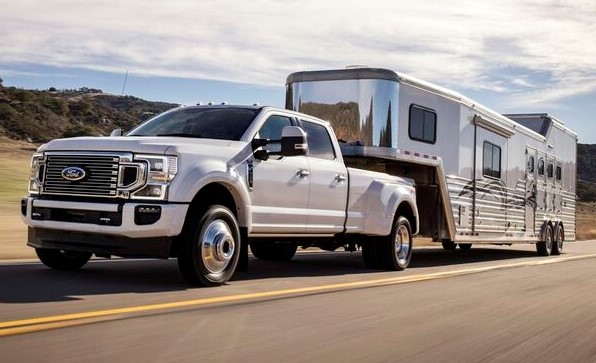
This F-450 (pictured above) was a Crew Cab in King Ranch specification, equipped with 4WD and a dual-rear-wheel (DRW) axle. With its heavy load, the 6.7L Power Stroke diesel’s cooling fans went into overdrive during the ascent, the truck maintaining the 45-mph (73-km/h) speed limit.
Constantino estimated the accelerator pedal was at 60% of its travel. At wide-open throttle, he claimed this F-450 would top out at 50 mph (81 km/h) while hauling the flatbed up the grade.
Maximum towing capacity for the ’20 Ford Super Duty is 37,000 lbs. (16,780 kg). To get it, choose the F-450 Regular Cab dually with 2-wheel drive, stick with XL trim and upgrade to the 6.7L Power Stroke.
Ford estimates the Regular Cab accounts for about 25% of Super Duty sales, while the Crew Cab is roughly 60% of the mix. An F-250 Crew Cab with the diesel tops out at 12,600 lbs. (5,715 kg), the F-350 Crew Cab maxes out at 22,400 lbs. (10,160 kg) (SRW) or 35,200 lbs. (15,970 kg) (DRW) and the F-450 Crew Cab is capped at 34,600 lbs. (15,695 kg).
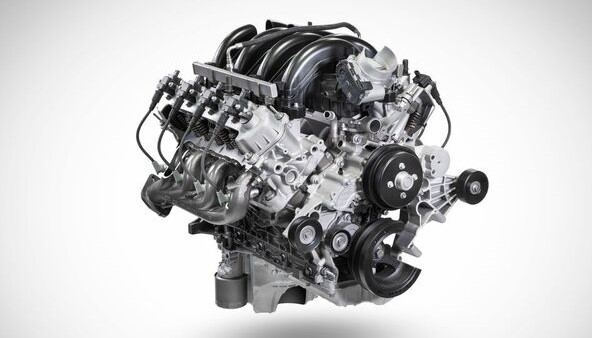
During a mostly highway drive in an unloaded F-250 Crew Cab with 4WD, Lariat trim and a short bed, the test truck returns 19.4 mpg. (12.1 L/100 km). But the Power Stroke diesel isn’t cheap, commanding a $10,495 premium over the F-250’s standard 6.2L V-8 and 6-speed automatic.
That’s where the ’20 Super Duty’s brand-new 7.3L gasoline V-8 (pictured above) will generate plenty of interest. Priced at $2,045 for the F-250 described above, a price that includes an upgrade from the 6-speed automatic to a new heavy-duty 10-speed unit, this all-new engine cranks out 430 hp at 5,500 rpm and 475 lb.-ft. (644 Nm) of torque at 4,000 rpm. Those are increases of 45 hp and 45 lb.-ft. (61 Nm) over the standard 6.2L gas V-8.
Maximum tow capacity for the 7.3L gas V-8 is 21,200 lbs. (9,616 kg) in a Regular Cab DRW with 2WD. Crew Cabs top out at 20,600 lbs. (9,344 kg).
Hauling a 9,000-lb. (4,082-kg) gooseneck livestock trailer up Yarnell Grade, the 7.3L worked harder than the Power Stroke diesel, even though the load fell 7,000 lbs. (3,175 kg) short of this particular F-250 Crew Cab 4WD SRW’s maximum gooseneck trailer rating. It sucked down more fuel, too, averaging 7.4 mpg (31.8 L/100 km) going up and then back down the mountain.
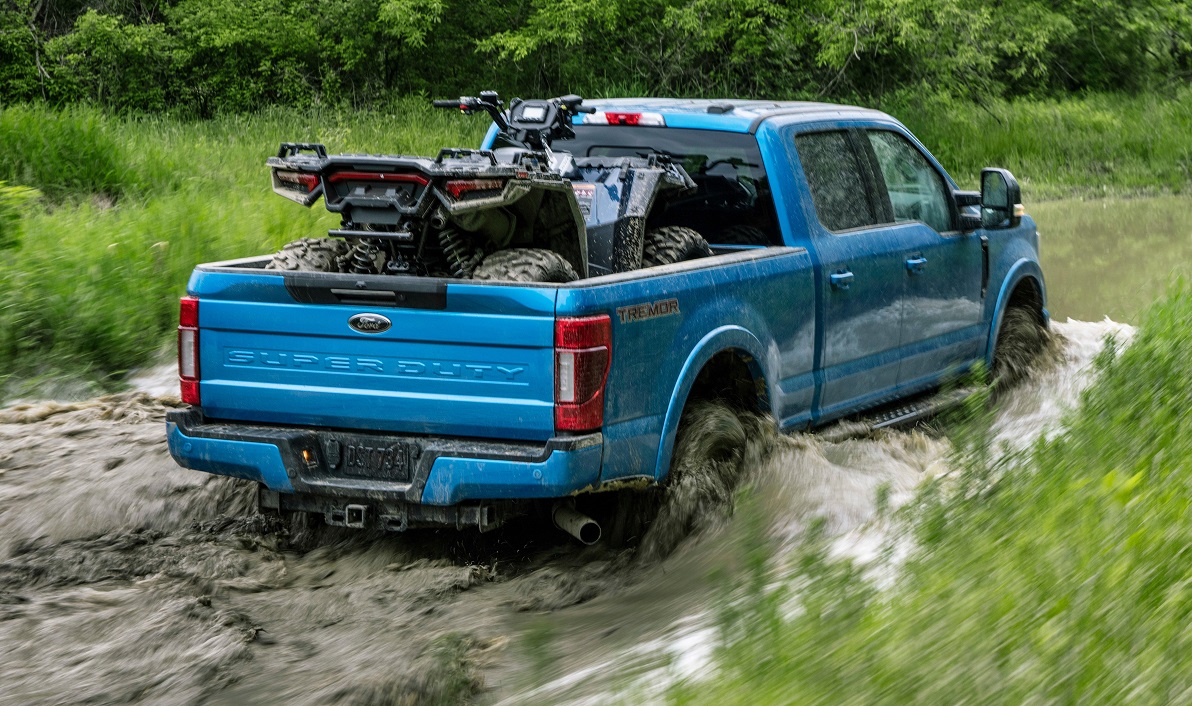
Installed in an F-350 Crew Cab 4WD SRW equipped with the new-for-’20 Tremor package (pictured above), and without a trailer or any payload in the short bed, the 7.3L eked out no better than 11.2 mpg (21 L/100 km) in combined driving conditions.
Tremor equipment preps the Super Duty for extreme off-roading. This version of the truck loses the deep front air dam to provide a 31.65-degree approach angle and equips the Super Duty with 35-in. Goodyear Wrangler Duratrac all-terrain tires wrapped around 18-in. matte black aluminum wheels.
These modifications, combined with a lifted front suspension and 10.8 ins. (274 mm) of ground clearance, don’t make for the most efficient application of the 7.3L V-8. But this gas-fueled engine sounds terrific as revs climb, and the 10-speed automatic expertly and quickly chooses the proper gear around town, while merging onto freeways and when passing slower vehicles.
The Super Duty Tremor also is adept off-road, as we learned at a quarry near Wickenburg, AZ. No doubt, Ford designed the course to highlight the Tremor’s unique capabilities and technologies. But in some spots, Ford’s new remote-controlled 12,000-lb. (5,433-kg) Warn winch upgrade (pictured below) would’ve added reassurance.
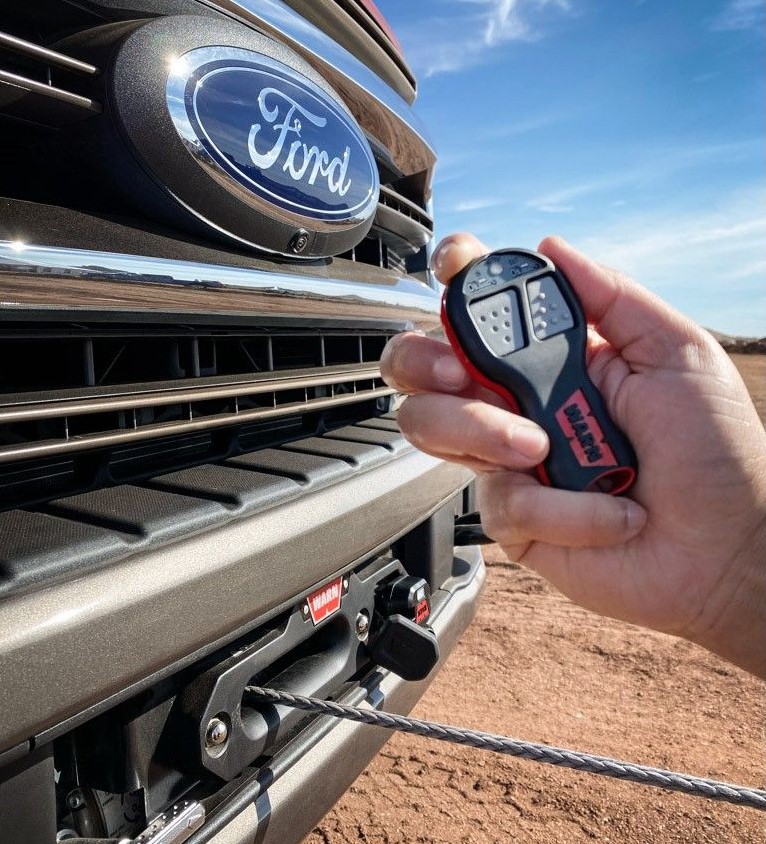 Nevertheless, thanks in part to the ’20 Super Duty Tremor’s 33-in. (0.8-m) water-fording capability, Rock Crawl driving mode, locking rear electronic differential and Dana limited-slip front differential, Trail Control system that works as an ultra-low-speed cruise control system, and both front and top-down camera systems, the truck tackled the topography with ease.
Nevertheless, thanks in part to the ’20 Super Duty Tremor’s 33-in. (0.8-m) water-fording capability, Rock Crawl driving mode, locking rear electronic differential and Dana limited-slip front differential, Trail Control system that works as an ultra-low-speed cruise control system, and both front and top-down camera systems, the truck tackled the topography with ease.
Speaking of cameras, the ’20 Super Duty now offers Ford’s Pro Trailer Backup Assist system, a semi-autonomous technology that steers the truck and a trailer while reversing.
To use this, the driver engages the system, refers to the reversing camera display on the Sync 3 infotainment screen and twists a dashboard knob in the direction the trailer should go. Pro Trailer Backup Assist then takes control of the truck’s steering to automatically guide the trailer in the desired direction.
This is just one of several new technologies available for the ’20 Super Duty. From newly standard FordPass Connect with a 4G LTE Wi-Fi hotspot and available wireless-device charging to a long list of advanced driver-assistance systems, the truck is a thoroughly modern workhorse. Depending on configuration, the Super Duty offers adaptive cruise control, forward collision warning, automatic emergency braking, lane departure warning and blindspot monitoring with conventional trailer coverage.
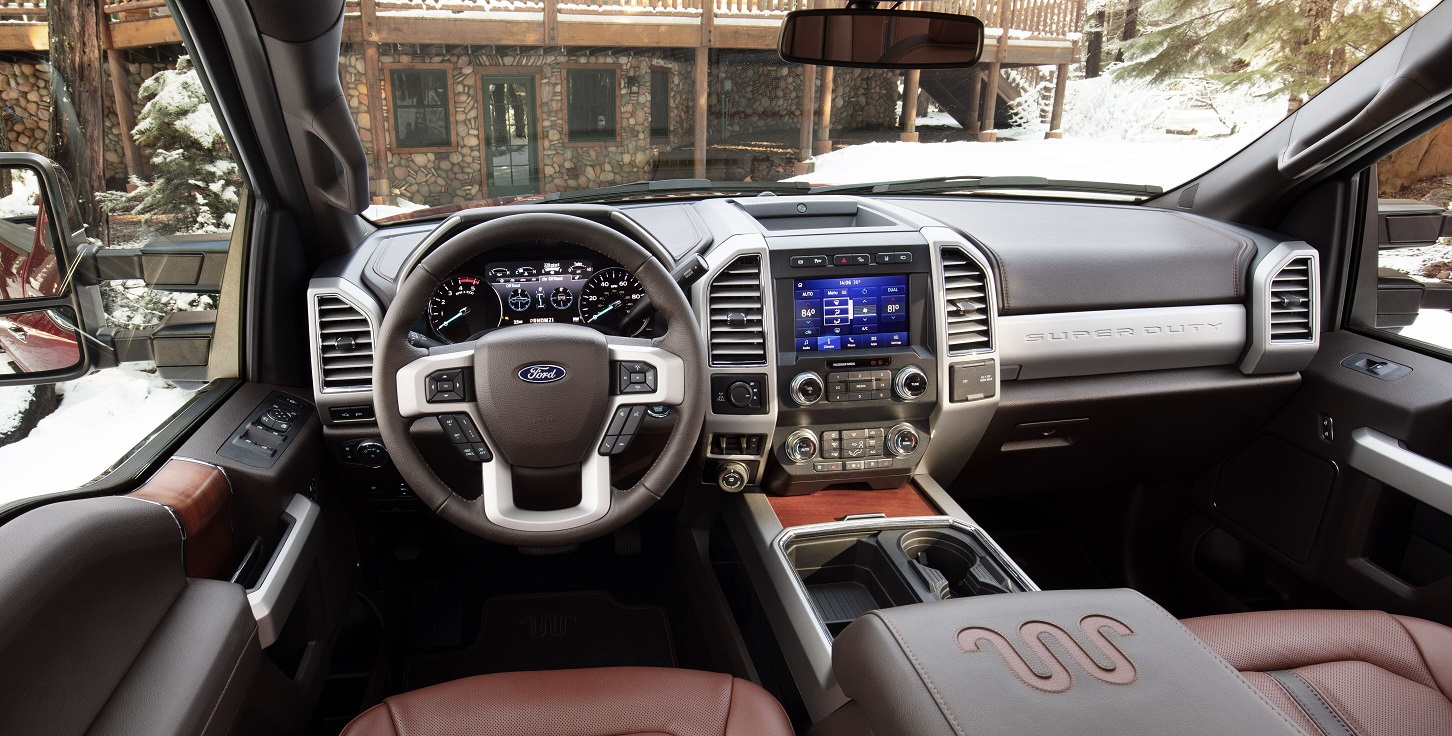
Minor styling and interior changes (pictured above), especially in higher trim levels, improve functionality, appearance and quality. Available power running boards make it easy to climb aboard and exit the Super Duty.
On sale now, the ’20 Ford F-Series Super Duty starts at $35,300 for a Regular Cab SRW with 2WD, XL trim and no options. At the other end of the lineup, an F-450 Crew Cab DRW with 4WD, Limited trim and every option reaches nearly $100,000. These prices include a $1,595 destination charge.
Just as the competition improves the Chevrolet Silverado HD, GMC Sierra HD and Ram Heavy Duty, the refreshed ’20 Ford F-Series Super Duty resets the bar in terms of towing, hauling and technological sophistication.
